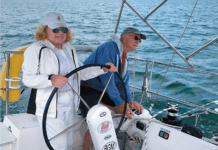Now, several years after equipping our Mason 43 for extended cruising , its painfully obvious that misconceptions about what a cruising sailboat really needs lie at the root of many problems with equipment and marine electronics&emdash;although there are still poorly designed pieces of gear that should be avoided entirely. For this article well look at the winners and losers after several thousand miles of use and a trans-Atlantic crossing. Gear well examine includes a 60-pound CQR anchor, Freedom 2000 inverter/charger, Link 2000-R monitor, SGC 2000 single sideband radio, Icom 710 SSB radio, NASA Target Pro-Plus Navtex receiver, Furuno NX-300 Navtex receiver.
****
Everyone faced with the task of fitting out a boat for cruising deals with the same hard questions: What do I really need, and what equipment will do the job reliably? There is no easy answer, no single source of information or reference to provide clear-cut answers. Choices are often guided by a hodgepodge of information derived from other peoples experiences, manufacturers claims, personal goals, intuition, and even random selection when all else fails.
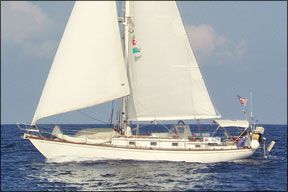
We relied on other peoples experiences when we equipped Southern Cross, our Mason 43. We paid particular attention not only to their choices in equipment, but how they used it, what was needed to maintain it, and&emdash;most importantly & emdash;whether it fit our perceived needs. Now, several years later, its painfully obvious that misconceptions about what is really needed lie at the root of many problems with equipment, although there are still poorly designed pieces of gear that should be avoided.
Anchoring
A cruising boat lives as much by its ground tackle as it does its sailing rig. The average cruising boat spends about five days inshore for every day under sail, and given todays marina prices, a lot of those inshore days will be spent at anchor.
Decisions here are fairly simple: You want the biggest, strongest anchor you can carry on the bow, backed up with the longest, heaviest chain you can stow, and a reliable windlass that can pick up the entire length of ground tackle when its hanging vertically from the bow roller. The windlass should have a workable backup in case of power or motor failure, and the bow roller should be well thought-out and heavily built.
We got this one right.
Southern Cross tips the scales at a little over 32,000 pounds, and her primary anchor is a 60-pound CQR backed up with 300 feet of galvanized 3/8-inch chain. Half-inch chain would be even better, but its just too heavy for Southern Cross bow.
I set the anchor with a minimum scope of 5 to 1, and really prefer 6 to 1, if there is room. Reaching the desired scope before attempting to set it with the engine seems to work the best, and easing it into the bottom with a bit of reverse before testing the set with more power eliminates a lot of problems. In deep water, I have occasionally used less scope when no more chain was available and have successfully anchored in nearly 100 feet of water with the full 300 feet of chain out. I would avoid this sort of anchorage, if you can. For a snubber, we use 5/8-inch, braided nylon secured to the chain with a camel hitch&emdash;really a rolling hitch with more wraps in each section&emdash;and to date, it has never let us down. The snubber is led over the roller with the chain, and the shallower the water, the more length I use, often ending up with 15 feet or more out in 8- to 10-foot depths.
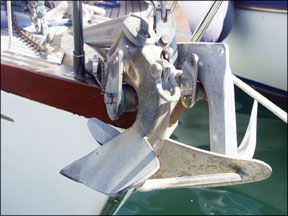
We have used the CQR in all kinds of bottoms&emdash;weed, sand, mud, and even some rocky patches&emdash;with almost total success. On several occasions, it held in winds upward of 50 knots for several days. But like most plow anchors, over a period of time, it may slowly move or plow a bit in really soft mud. With the large selection of anchors on the market, its important to be aware that there is a significant difference in strength between the drop-forged steel of anchors like the CQR and the weaker, welded-steel-plate anchors.
Electrical system
Another one we got right. We run almost everything from what I hoped would be a bulletproof 12-volt DC platform. The combination of a Freedom 2000 inverter/charger and a Link 2000-R monitor (both sold under the Xantrex name) controlling both the engine alternator and the Freedoms output to our Lifeline AGM batteries has been rock-solid for years. The first set of Lifeline AGM batteries lasted well over eight years, and I think I inadvertently shortened their life a bit by using too high of a voltage during the equalizing phase of charging. We run virtually everything from this platform, including fairly high-draw items like a big 1/3-horsepower refrigeration compressor motor and a watermaker. The Link system has survived several near misses with lightning strikes and lots of pounding with RF from the SSB, and it never misses a beat. The Link 2000-R and inverter/chargers are readily available, but the marine version of the Freedom inverter/charger can be used with both 50 and 60 Hz AC power. This is a feature that we depend on heavily in European waters where our shore power transformer supplies 120 volts at 50 Hz power to the boat whenever we plug in at a marina.
Allowing the Link 2000-R to regulate engine alternator output has several advantages, but also a potential weakness. Failure of the Link system with its interdependent alternator regulator would mean complete loss of alternator charging capability. The Freedom inverter/charger can be run independently if the Link system fails, but the alternator regulator cannot.
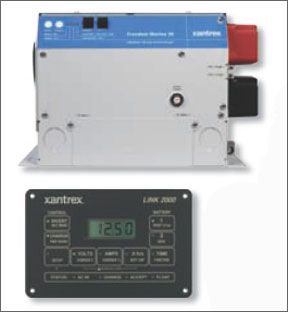
As a backup, we installed a stand-alone, three-stage regulator on the panel beside the Link system regulator. The plan, in case of failure, was to move the leads from the Link regulator to the backup regulator and be charging again in short order. Aside from occasionally connecting it to see if it still works, the backup regulator has been decorating the compartment wall for eight years and has never been needed.
sgc 2000 SSB transceiver
I really blew this one. Our nav station is too small to support a full-size marine SSB transceiver, so we decided to go with a SGC 2000 with a small control head mounted at the chart table and the main chassis tucked away in a locker. While this solved the space problem, the SGC 2000 created its own problems. Before we left for our voyage, it failed twice. Although SGC repaired it under warranty each time, this wasnt what I had in mind for a piece of cruising equipment.
After I diligently removed all the components, I gave the SGC 2000 to a fellow cruiser who was determined to give it a try. In another year or so, it had failed again and he gave up on it. Ultimately, we both installed an Icom 710RT.
Icom 710 transceiver
The Icom 710 is available as a single unit or in the RT version, which comes with a separate control head to allow remote mounting of the main chassis. Our 710 RT version has been totally reliable for many years, and performance has been excellent. We depend heavily on this radio, combined with a Pactor Modem for e-mail, weather fax, news, and communications.
The radio itself is only half of the equation, though. A proper antenna like the insulated backstay we use is fairly easy to set up, but a good ground plane is another matter. We have had good results with the tuner mounted in the lazerette, a few feet from the backstay, and a 4-inch-wide strip of copper embedded in the hull around the waterline for a ground plane. A lot has been written about creating a good SSB antenna ground plane, but getting a good Pactor modem installation is another issue entirely. These gadgets are very sensitive to RF noise and require good filtering to work right. You can spend a few days tinkering with filter capacitors and chokes, or you can purchase a pre-assembled cable setup complete with filtering from HF Radios (www.hfradio.com) Don Melcher. He is knowledgeable and has a selection of suitable SSB transceivers and Pactor modems, or he can help you set up an existing transceiver with a modem. When I plugged together our new HF Radio setup, we successfully sent e-mail from the first attempt and have continued to do so for many years now.
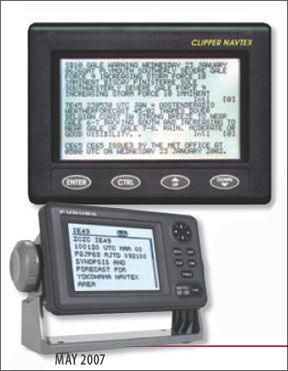
Nasa Navtex Receiver
Although Navtex is available in North America, U.S. boaters don’t often use it. However, in many parts of the world this may be the only source of weather and bulletins in English. A Navtex receiver listens on one of two different frequencies, 518 and 490 kHz. Transmissions on 518 kHz are in English, but the 490 kHz frequency is used by individual countries for local weather and is frequently transmitted in the local language. This isn’t all bad. In the UK, for example, the shipping forecast is always available on the higher frequency, but a local weather forecast for small craft, also in English, is broadcast on 490 kHz, so having the ability to receive both frequencies can be useful.
Navtex transmissions encompass areas where you might easily be 100 miles or more from the transmitter, and at these low frequencies, a sensitive receiver is a must. I originally installed a Nasa Target Pro-Plus Navtex receiver and had continual difficulties with receiving stations at any great distance. After consulting with the folks at Nasa, the antenna was relocated several times and a ground added. However, we still couldnt receive anything from more than a few miles away. In the end, it went the way of all things unproductive and found a new home.
My next attempt was a Furuno NX-300 Navtex receiver. The difference was immediately apparent. Its so sensitive that while anchored in Turkey, we were getting messages from the Suez Canal area to the other side of Greece. Fortunately, Navtex receivers allow you to select which stations you are interested in. The Furuno receiver takes this a step further. If you connect a GPS signal, it automatically selects stations within a preset distance, if desired. This is a nice feature, in our opinion.
With the little, mushroom-shaped antenna mounted on the stern pulpit, perhaps closer than it should be to other metal, and no special ground, it still works well. The NX-300 can receive only one frequency at a time (as selected by the user). A few Navtex receivers incorporate dual-channel capability and can receive both frequencies at the same time, but the reliability and long-range reception of the NX-300 made it a winner for the
Southern Cross crew.



































